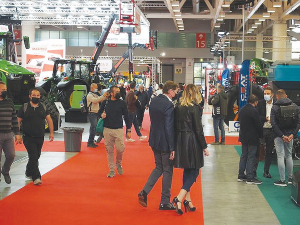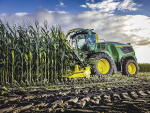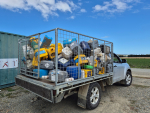The desire for face-to-face business was recently demonstrated by the return of the 44th EIMA Show in Italy - the first major event of its type since the onset of Covid.
Some 270,700 visitors, more than 25,000 from overseas, donned face-masks and applied hand sanitizer to explore the 1350 exhibitor sites and gather information and place orders for the latest equipment in the agricultural sector.
The event organisers delivered some interesting statistics, which confirms the resurgence of commerce post-Covid, at least in the global agricultural machinery industry.
With deliveries of tractors being used as the key barometer, sales of tractors in the US - for the first nine months of 2021 - hit 246,000 units (+12%).
Meanwhile, during the same period, the expansive Indian market stood at 680,000 tractors (+25%). Likewise, tractor sales in Europe were healthy: Germany recorded 25,700 sales (+6.8%), the UK 11,247 (+25%) and Italy 18,510 - an increase of 44%.
This post-Covid recovery is attributed to good crops in key areas such as the Russian Federation and Australia. Reports also suggest that global rice production has hit an all-time high of 520 million tonnes (+1.3%) and total grain output is likely to hit 2.8 billion tonnes (+1.1%).
Commentators suggest that by 2030 international agricultural production will have increased 18% and livestock production 13% to meet demands created by population growth.
"This market boom is due to a set of reasons partly linked to the global economic recovery, with the increase in world GDP expected to be 5.9% in 2021 and 4.9% in 2022," explained FederUnacoma President Alessandro Malavolti. "And partly linked to the good performance of agriculture and its growth prospects in the coming years."
While there was a positive mood at the event, FederUnacoma (the association of European machinery manufacturers), warned that things might come to a screeching halt, because of logistics and the spiralling costs of raw materials.
In the case of the former, as of mid-October, the World Container Composite Index - a system used to monitor container rental values on all the major global routes - has increased 292% over 2020.
Commodity costs are also skyrocketing, with energy costs up 365%, sheet metal up 234%, hot-rolled coils up 200%, while polythylene climbed by 160% and polypropylene by around 123%.
Many of these increases are being attributed to Chinese political strategy, particularly in the reduced exports of steel and ferrous metals, in favour of satisfying increased local demand. That same strategy is also causing problems with the supply of silicon, essential for microchips and semi-conductors - essential components in many machines. This has seen rises in cost of over 300% in less than two months.
More recently, the supply of magnesium - where China produces around 85% of world demand - has also become severely constrained. This has created major production issues as it is a key component of alloy castings.
"If the tensions around the supply of raw materials does not return to normality in the near future, we believe that stocks held by manufacturers will last no more than six to eight months," FederUnacoma added.



















